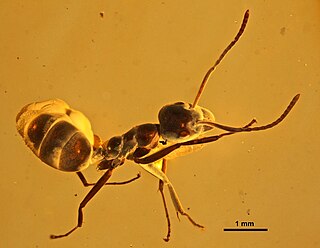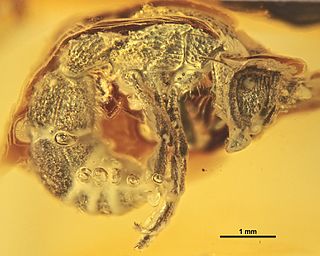
Baltic amber or succinite is amber from the Baltic region, home of its largest known deposits. It was produced sometime during the Eocene epoch, but exactly when is controversial. It has been estimated that this forested region provided the resin for more than 100,000 tons of amber. Today, more than 90% of the world's amber comes from Kaliningrad Oblast of Russia. It is a major source of income for the region; the local Kaliningrad Amber Combine extracted 250 tonnes of it in 2014 and 400 tonnes in 2015.
Paleontology or palaeontology is the study of prehistoric life forms on Earth through the examination of plant and animal fossils. This includes the study of body fossils, tracks (ichnites), burrows, cast-off parts, fossilised feces (coprolites), palynomorphs and chemical residues. Because humans have encountered fossils for millennia, paleontology has a long history both before and after becoming formalized as a science. This article records significant discoveries and events related to paleontology that occurred or were published in the year 1868.
Paleontology or palaeontology is the study of prehistoric life forms on Earth through the examination of plant and animal fossils. This includes the study of body fossils, tracks (ichnites), burrows, cast-off parts, fossilised feces (coprolites), palynomorphs and chemical residues. Because humans have encountered fossils for millennia, paleontology has a long history both before and after becoming formalized as a science. This article records significant discoveries and events related to paleontology that occurred or were published in the year 1893.

Prionomyrmex is an extinct genus of bulldog ants in the subfamily Myrmeciinae of the family Formicidae. It was first described by Gustav Mayr in 1868, after he collected a holotype worker of P. longiceps in Baltic amber. Three species are currently described, characterised by their long mandibles, slender bodies and large size. These ants are known from the Eocene and Late Oligocene, with fossil specimens only found around Europe. It is suggested that these ants preferred to live in jungles, with one species assumed to be an arboreal nesting species. These ants had a powerful stinger that was used to subdue prey. In 2000, it was suggested by Cesare Baroni Urbani that the living species Nothomyrmecia macrops and a species he described both belonged to Prionomyrmex, but this proposal has not been widely accepted by the entomological community. Instead, scientists still classify the two genera distinctive from each other, making Nothomyrmecia a valid genus.

Eulithomyrmex is an extinct genus of ant in the formicid subfamily Agroecomyrmecinae. The genus contains two described species, Eulithomyrmex rugosus and Eulithomyrmex striatus. Eulithomyrmex is known from a group of Late Eocene fossils which were found in North America.

Agroecomyrmex is an extinct genus of ants in the formicid subfamily Agroecomyrmecinae, for which it is the type genus. The genus contains a single described species, Agroecomyrmex duisburgi. Agroecomyrmex is known from a group of Middle Eocene fossils which were found in Europe.

Aphaenogaster longaeva is an extinct species of ant in formicid subfamily Myrmicinae known from a solitary Eocene or Oligocene fossil found in North America. A. longaeva was one of five insect species described by the paleoentomologist Samuel Hubbard Scudder in an 1877 paper.

Aphaenogaster sommerfeldti is an extinct species of ant in the subfamily Myrmicinae known from a group of Middle Eocene fossils found in Europe. A. sommerfeldti is one of three species in the ant genus Aphaenogaster to have been noted from fossils found in Baltic amber by William Morton Wheeler.

Aphaenogaster oligocenica is an extinct species of ant in the subfamily Myrmicinae known from a pair of Middle Eocene fossils found in Europe. A. oligocenica is one of three species in the ant genus Aphaenogaster to have been noted from fossils found in Baltic amber by William Morton Wheeler.

Asymphylomyrmex is an extinct genus of ants in the formicid subfamily Formicinae. The genus contains a single described species, Asymphylomyrmex balticus and is known from a group of Middle Eocene fossils which were found in Europe.

Yantaromyrmex is an extinct genus of ants first described in 2013. Members of this genus are in the subfamily Dolichoderinae of the family Formicidae, known from Middle Eocene to Early Oligocene fossils found in Europe. The genus currently contains five described species, Y. constrictus, Y. geinitzi, Y. intermedius, Y. mayrianum and Y. samlandicus. The first specimens were collected in 1868 and studied by Austrian entomologist Gustav Mayr, who originally placed the fossils in other ant genera until the fossils were reviewed and subsequently placed into their own genus. These ants are small, measuring from 4 to 6 mm in length and can be characterized by their trapezoidal shaped head-capsules and oval compound eyes that are located slightly to the rear of the capsules midpoint, with no known ocelli present.

Dolichoderus balticus is an extinct species of Eocene ant in the genus Dolichoderus. Described by Mayr in 1868, the fossils of a worker, queen and male of the species were discovered in the Baltic Amber.

Dolichoderus mesosternalis is an extinct species of Eocene ant in the genus Dolichoderus. Described by William Morton Wheeler in 1915, a fossilised worker of the species was found in the Baltic amber.

Dolichoderus passalomma is an extinct species of Eocene ant in the genus Dolichoderus. Described by William Morton Wheeler in 1915, a fossilised worker of the extinct species was discovered in Baltic amber.

Paraneuretus is an extinct genus of formicid in the ant subfamily Aneuretinae known from fossils found in Asia and Europe. The genus contains three middle to late Eocene age species, Paraneuretus dubovikoffi, Paraneuretus longicornis, and Paraneuretus tornquisti.

Bradoponera is an extinct genus of ant in the Formicidae subfamily Proceratiinae, and is one of four genera of the subfamily. The genus contains four described species Bradoponera electrina, Bradoponera meieri, Bradoponera similis, and Bradoponera wunderlichi. The species are known from several Middle Eocene amber fossils which were found in Europe.

Procerapachys is an extinct genus of ants which existed 37 to 42 million years ago. A member of the subfamily Dorylinae of the family Formicidae, Procerapachys was first described by American entomologist William Morton Wheeler in 1915.

Electromyrmex is an extinct genus of ants in the formicid subfamily Dolichoderinae. The genus contains a single described species, Electromyrmex klebsi and is known from a group of Middle Eocene fossils which were found in Europe.

Nylanderia pygmaea is an extinct species of formicid in the ant subfamily Formicinae known from fossils found in the Prussian Formation of the Baltic region.
The Prussian Formation, previously known as the Amber Formation, is a geologic formation in Prussia, today mostly Kaliningrad Oblast that dates to the Eocene. It holds 90% of the world's amber supply and Baltic amber is found exclusively in the Prussian Formation.

















